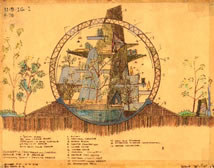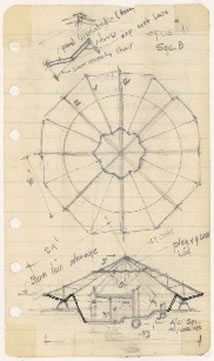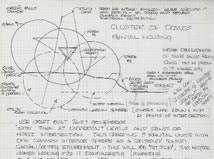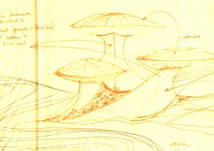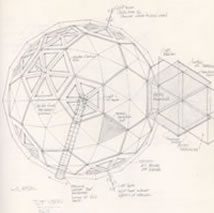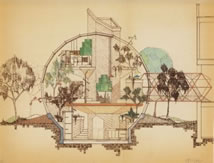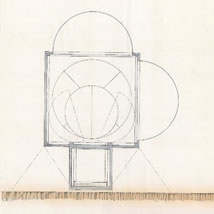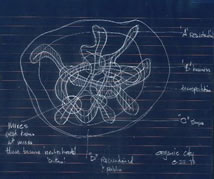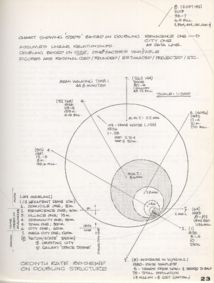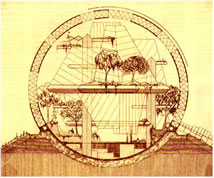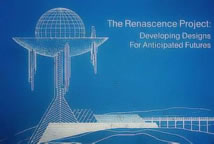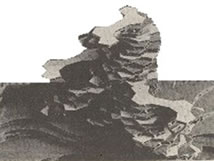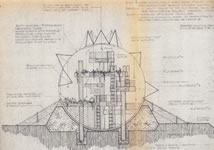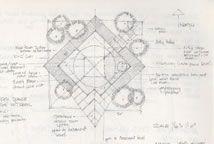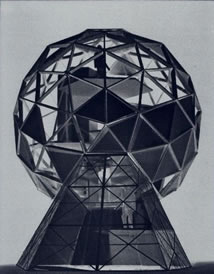Work 26
1964
- Renascence Project
|
|
Client:
Work:
Design:
Location:
Status:
Notes:
|
Matt
Taylor and Max Stormes
Design-Build-Use
Matt
Taylor
Phoenix, Arizona - Outside of Lake Havasue City
Not Built
Max and I along with a couple form New York bought
several hundred acres of land in Arizona. The idea was to
build a community of artist designers. Business disagreements
and the death of our partners in a car accident left the
project forever on paper. The ultimate size of this project
would have been large (several hundred “families”)
even though the sense of scale was deliberately kept intimate.
The project was designed so that much of it’s infrastructure
was underground with only the “tops” of the interconnected
buildings showing almost like eruptions out of the steep,
rugged landscape. Parking was to be kept to a single place
at the entry to the property and project.
|
|
Work 27
1964
- Cluster Housing Community
|
|
Client:
Work:
Design:
Location:
Status:
Notes:
|
Project
Design
Matt
Taylor
Phoenix, Arizona
Study
A By this time, I had worked on several subdivisions
of hundreds of houses each for developers and architects
in California and Arizona. The land use model never worked
as far as I was concerned. The “lots” were too
big or too small depending how you looked at them. The landscape
had no chance. There was a built-in tragedy of the commons.
The street grid was imposed on the site and, even if not
strictly rectilinear, arbitrary in terms of preserving the
features of the landscape. Individual attempts at landscaping
the small strips of land around and between houses resulted
in a hodgepodge of solutions. this is not effecient land
use nor is it ecologically sound development. The idea of
cluster housing is to create very small lots (all of which
are totally buildable) and group then in clusters around
a front commons with the lots opening onto commons areas
that cannot be closed off or built upon. The character of
the landscape is maintained, owners have less “land”
to take care of and the same density (or even greater) is
accomplished with a sense of greater open space. Some aspect
s of these ideas became common in development like on Hilton
Head Island but have never reflected the level of design
that I had in mind.
|
|
Work 28
1965
- Three Houses on a Cul_De_Sac
|
|
Client:
Work:
Design:
Location:
Status:
Notes:
|
Phoenix
Developer and Bank
Design
Matt
Taylor
Phoenix, Arizona
Not Built
This was a case of a client coming for something
different, getting what they asked for, then saying the
could not build it because it was different.
|
|
Work 29
1965
- Pool and House Addition
|
|
Client:
Work:
Design:
Location:
Status:
Notes:
|
John
and Wally Shamy
Design-Build
Matt
Taylor
Phoenix, Arizona
Built
A 1
|
|
Work 30
1965
- Zoned Pool and patio
|
|
Client:
Work:
Design:
Location:
Status:
Notes:
|
Xxxx
Design
Matt
Taylor
Phoenix, Arizona
Built
A 1
|
|
Work 31
1967
- Picture Frame Shop
|
|
Client:
Work:
Design:
Location:
Status:
Notes:
|
Xxxx
Design
Matt
Taylor
Phoenix, Arizona
Built Without Supervision
A 1
|
|
Work 32
1967
- Hexagonal Residence
|
|
Client:
Work:
Design:
Location:
Status:
Notes:
|
Xxxx
Design
Matt
Taylor
Phoenix, Arizona
Not Built
A 1
|
|
Work 33
1967
- Desert Oasis
|
|
Client:
Work:
Design:
Location:
Status:
Notes:
|
Project
Deign
Matt Taylor
Phoenix, Arizona
Study
This design came about as the result of a “challenge.”
I was teaching a course in architectural design and had
concluded the section on the use of connotation and denotation
in the development of theme in the design process. The students
wanted an example. I Gave them a half hour to come up with
a project and told them that I would respond on the spot
with a design. Naturally, they made the problem (in their
mind) as difficult as they could. Difficult, in this case,
by coming up with a building type - that on the surface
of it - had no real intrinsic architectural value or opportunity:
a gas station, rest stop, eating facility on the highway
mid way between Phoenix and Tucson. Of course, it was easy
- and - illustrated the utility of the technique of employing
connotation as the translator between program and architectural
concept.
|
|
Work 34
1967
- Zoned Residence
|
|
Client:
Work:
Design:
Location:
Status:
Notes:
|
Xxxx
Design
Matt
Taylor
Phoenix, Arizona
Not Built
A 1
|
|
|
Client:
Work:
Design:
Location:
Status:
Notes:
|
Project
Design
Matt Taylor
Phoenix, Arizona
Project
This began my thinking about separating the shell
of the building from the interior elements - in other words,
build a building within a building. The shell become the
environment value much like the atmosphere is to the Earth
and it’s inhabitants. Inside, one lives in a waterproofed
temperate climate therefor allowing lightweight, adjustable
inexpensive building components. An adaptable habitat that
adjusts to the inhabitants not the other way around. The
majority of my work, starting with this one and continuing
through work # 63, takes a new turn. A set of issues
came to the fore: energy and food self-sufficiency, new
strategies for siting and building adaptability/mobility,
new economic and collaborative use models. Cohousing is
the term that is used today for a movement that has been
strong in Europe since the 60s and has increasingly found
support in the US since the 70s. I was unaware of all this
when I started this investigation. The economics, as well
as, the community aspect hit you in the face the minute
a little thought is given too it. Or, another way of saying
it is that the economics of the single family dwelling and
suburban sprawl taken to the extreme are what hit you in
the face. In the ecology of architectural types there certainly
is a place for the single family dwelling but it is far
from the best model for the “default” solution
for general housing.
|
|
Work 36
1969
- Sphere House
|
|
Client:
Work:
Design:
Location:
Status:
Notes:
|
Project
Design
Matt
Taylor
Phoenix, Arizona
Project
A 1
|
|
|
Client:
Work:
Design:
Location:
Status:
Notes:
|
Project
Design-Facilitate
Matt
Taylor
Kansas City, Missouri
Published
A project of great importance. The present adversarial
process between city and state governments and individual
builders, owners and users and community groups is netting
out to the destruction of architecture and planet. There
is no reason for this. A better METHOD
is possible. The Kansas City Master Plan proposed a 11 mile
pedestrian mall down what is now Main Street (red line).
It connects all the major nodes (green/grey areas) from
the old airport on the North to Ward Parkway Shopping Center
on the South. Between these two poles are several places
of economic and cultural interest - the main concentration
is in the shaded (grey) areas of the map. And, all kinds
of built environments and communities of many cultures and
economic strata are contained in the one mile band on either
side of Main Street, The Boulder
Mall build later in the decade accomplished, on a much
smaller scale, the character of environment I envisioned
for the shaded area. Transportation would be provided by
a (very) light rail trolley system with high density automobile
parking garages a block off of Main Street about every half
mile. The idea was that the Mall could be built as part
of a World’s Fair celebration. The nodes that I speak
of were, at the time, strong concentrations of educational,
cultural, recreational commercial, retailing and residential
districts. They have continued to develop over the the last
three decades. Every kind of civic function and building-type
can be found in this 12 square mile area. Main Street remains
a major corridor but little still ties theses areas together.
General developed has helped, however, the entire area still
lacks an Armature.
The paradox is, that one of these nodes is the famous multi-block
Nichol’s PLAZA
which is regarded as the world’s first shopping center.
It is still viable today and a clear demonstration how urban
development can be done. The truly radical aspect of this
project, however, was the transparency of the method. It
was this aspect that is missing from development and why
development is limited to the scope that any one developer
can control or “flips” to the huge government
controlled mega-projects that tend to be dead on arrival.
The interesting thing about this project, specifically,
is that to a stranger moving to Kansas City, this “KC
Strip” was trying to happen. It is still trying to
happen. Yet, the social mechanism in place cannot facilitate
it happening. When a “natural” like this cannot
be brought about, in a city that has - by conventional standards
- extremely good stewardship from prominent individuals
and corporations, then imagine the plight of most American
cities that grew up not blessed with any natural or (even
simi) human-built Armature. All that is left is sprawl.
It was my intention that the areas off the Mall be turned
into mixed use developments and also employ the other design
strategies I developed at the time: co-housing, Domiciles,
movable buildings and alternative energy systems. See Works
#35, #38, #42, #48, #50,
#53,#58 and #61, #68. Because
of the landscape and park system which could be extended
and connected to each other and other parks, a couple of
mega-structures would have fit in time (#70). the
result of this approach - and it can be done today - would
be a diverse, rich urban landscape that made PLACE
and fit the requirements of all the people-types and work-life
styles that make up a replacement city culture.
|
|
Work 38
1971
- Yurt House
|
|
Client:
Work:
Design:
Location:
Status:
Notes:
|
Project
Design
Matt Taylor
Kansas City, Missouri
Concept
A modern tent for a very simple and inexpensive lifestyle.
Comfortable, fun, easy on the landscape. About a week to
build and site - a couple of days to take away. Can we use
land like animals and indigenous peoples? What is the actual
value in cementing structures to the ground? Try living
in a garden under a translucent roof protected by earth
berms of flowering plants. This is not prestige housing.
It is simple, affordable, organic and focussed on natural
processes and systems. It is shelter that can be experienced
as shelter not life removed from the world “outside.”
|
|
Work 39
1972
- Drive-in Theater Buildings
|
|
Client:
Work:
Design:
Location:
Status:
Notes:
|
Commonwealth
Theaters, Inc.
Design
Matt
Taylor
Kansas City, Missouri
Not Built
One of my first uses of suspension structures. The
idea of the design was to promoted the easy reuse of land.
If buildings can be easily moved, it is possible to better
accommodate the economic cycles of real estate. In the early
periods of land development, land is almost always “underdeveloped.”
As land grows in value, buildings are torn down and replaced.
This is expensive and ecologically unsound. The notion is
to build, in these early stages, in a way that expects and
facilitates cycling buildings designed to be moved as the
land use requirements change. Work #48 explored this
idea further. Commonwealth was building a drive-in theater
on a piece of land that clearly would soon be used for a
denser use. I thought the economics would be better served
to create a solution that could be moved to another similar
use and so on again. Employing suspension structures makes
it possible to have large structures that rest on small
footings. This makes moving easier with less resulting site
work.
|
|
Work 40
1973
- Cycle Systems Shop
|
|
Client:
Work:
Design:
Location:
Status:
Notes:
|
Cycle
Systems, Incorporated
Design-Build-Operate
Matt
Taylor
Kansas City, Missouri - Kansas Suburb
Built
A 1
|
|
Work 41
1973
- Ocean City
|
|
Client:
Work:
Design:
Location:
Status:
Notes:
|
Project
Design-Research
Matt
Taylor
Kansas City - any Ocean
Concept
A human made island floating in the Ocean as a way-point
between land masses. Japan will do this some day. Properly
done, ocean cities can be safer and have less negative ecological
impact than building on the land. I am convinced that, within
this century,
|
|
Work 42
1973
- Dome Cluster Apartments
|
|
Client:
Work:
Design:
Location:
Status:
Notes:
|
Project
Design
Matt Taylor
Concept
Kansas City, Missouri
This concept has one innovation embedded in it’s approach.
This is that a cluster of domes built out, as illustrated
by Works #35 and #58, can allow a much greater
penetration into the ground while still bringing light and
a sense of vista to those lower levels. This can greatly
increase density and reduce overall visual impact of the
structure, on a typical urban lot, and also take advantage
of earth-sheltered virtues. Properly done, there should
be little negative sense of being “underground.”
Although presented as a single dome and a much smaller scale,
Work #53 shows that this can be accomplished. In addition,
selecting which functional areas are placed in both the
lower and upper areas of the domes are important to the
success of the scheme. The proposed scale of this project
was on the order of several Domiciles (#58) and offered
as a serious alternative to typical apartment housing and
the several obvious drawbacks of this typical approach:
low variety, usually dull geometry, poor energy strategies,oversized
footprint and scale problems, poor utilization of commons
and surrounding landscape. Many of these same sins could
be committed while employing the dome-cluster approach,
however, intrinsic to the basic configuration are more powerful
means to avoid these results. The traditional boxws within
boxwes approach of the typical apartment building simply
does not have the inherent variety necessary to avoid them.
On a much smaller scale, the difference between office cubicles
and the AI WorkPod
unit illustrates (on a two-dimensional plane) what this
layout accomplished in the three-dimensional realm.
|
|
|
Client:
Work:
Design:
Location:
Status:
Notes:
|
Project
Design
Matt Taylor
Kansas City, Missouri - Any Ocean Front
Concept
There are many ecologically sensitive areas that
are are also highly desirable as human habitats. Barrier
island beaches rank high in this regard. However, conventional
development is both subject to periodic destruction and
is also highly destructive to the natural habitat itself.
A reciprocal relationship of mutual destruction. This design
addresses this situation head on. It proposes a few dense
(volume) mega structures that carefully leaves the vast
majority of the landscape able to shift and move around
these structures. Barrier islands remain stable because
they can move. To attempt to built ON this kind of
landscape is foolish. This schema places a few buildings
that rest on vertical shafts that go deep creating a strucural
stability independent of surface conditions. Horizontal
stability is accomplished by tying the structures together
above the beaches themselves. Indigenous landscaping is
encouraged between the structures and to the beach. Traffic
is limited to the bearing capacity of this ecosystem. Transportation
is monorail back to car parking areas removed from the beach
areas. The buildings themselves are mixed use and self-contained
to the maximum possible degree. Construction is prefabricated
with components airlifted in order to reduce site disturbance.
|
|
Work 44
1974
- Far East Bazaar Shop
|
|
Client:
Work:
Design:
Location:
Status:
Notes:
|
Xxxx
Design-Build-Setup Operations
Matt
Taylor
Kansas City, Missouri - Kansas Suburb
Built
A 1
|
|
Work 45
1974
- Leather Shop
|
|
Client:
Work:
Design:
Location:
Status:
Notes:
|
Ca
De
Matt
Taylor
St.
Built with alterations and without supervision
A 1
|
|
Work 46
1975
- Lee Wald Offices
|
|
Client:
Work:
Design:
Location:
Status:
Notes:
|
Lee
Wald Garment Company
Design and Construction Management
Matt Taylor
Kansas City, Missouri
Built
A most interesting project and my first large scale
office landscape. I made extensive use of interior landscaping
a feature unusual at the time and still rarely done on the
scale of this project. The interiors read like work stations
and office in a park.
|
|
Work 47
1975
- Attorney’s office
|
|
Client:
Work:
Design:
Location:
Status:
Notes:
|
Ca
De
Matt
Taylor
St.
Built
A 1
|
|
Work 48
1975
- Movable Offices
|
|
Client:
Work:
Design:
Location:
Status:
Notes:
|
Project
Design
Matt
Taylor
Kansas City
Study
With this project I got serious with exploring was
that the building type and design can better facilitate
fitting into the life cycle economics of land value and
development. The idea is to make building that have utility
and can be moved when the land value rises thus requiring
a different kind of building or greater density of building.
To be able to do this without great expenditures of time
or money and to be able to reuse the building removed
in
a similar situation elsewhere. In this design, this is
accomplished by manufacturing a very light weight structure
that sits on a small core and cantilevers in all directions
from that core. This makes for minimal footings and space
for
landscaping and parking beneath the structures.
|
|
Work 49
1975
- “Sears” House
|
|
Client:
Work:
Design:
Location:
Status:
Notes:
|
Project
Design
Matt
Taylor
Kansas City, Missouri
Study
This concept married, retailing, computer technology,
prefabricated building with the idea of a rule-based design
process to provide a method capable of producing middle
class housing in large numbers. I called it the “Sears”
in recognition that Sears provided thousands of houses through
it’s catalog in the 19th and early 20th century. A
completely integrated service was designed: design, financing,
field erection and maintenance service. This project took
the swimming
pool method, automated it and extended it to the entire
country and, ultimately, the world.
|
|
|
Client:
Work:
Design:
Location:
Status:
Notes:
|
Project
Design
Matt Taylor
Kansas City, Missouri
Concept
A return to the question: “What is the Minimum
Living Unit that provides a sustainable, beautiful and
satisfying life?” Affordable housing is not just scaling
down the building to what can be “afforded” -
it is about shedding things and costs that do not add value
to a life. Where is the “contemplative” life?
At what point does individual housing become both an individual
and social cost far greater than the value received? As
a society, we have not explored the “top end”
of affluent housing - we have not adequately explored the
intrinsic value of more modest approaches. I do not believe
we know what true luxury is - we certainly do not know what
is sustainable. Long term mortgages and the tactics of buying
to sell for capital gains has destroyed the vast majority
of domestic architecture. The home has become a commodity
not a place of beauty and refuge.
|
|
Work 51
1975
- Savings and Loan Bank Building
|
|
Client:
Work:
Design:
Location:
Status:
Notes:
|
Ca
De
Matt
Taylor
St.
Built and still in sevice
A 1
|
|
|
Client:
Work:
Design:
Location:
Status:
Notes:
|
Harold
Steinmeyer
Design-Build
Matt Taylor
Kansas City, Missouri - Kansas suburb
Not Built
My first self contained house design for a client.
The house is a “homestead” designed to be “worked”
like a landscape. It rests on a different concept of lifestyle
than conventional architecture. Structurally, the Steinmeyer
Residence ’s system is a precursor to the Bay
Area Studio project (# 96). Both the main house
(to the right in the elevation) and the carport (to the
left) are prefabricated wood sections suspended on steel
cables that hang from the masonry core units.
|
|
|
Client:
Work:
Design:
Location:
Status:
Notes:
|
Richard
S. Haitch
Design-Build
Matt Taylor
Kansas City, Missouri
Not Built
A large house in a traditional neighborhood that had been
turning into a rooming house. How to expand it without compromising
either the addition or the existing architecture? The answer
was a berm protected geodesic dome connected
to the house by a bridge.
|
|
Work 54
1975
- Learning Pods
|
|
Client:
Work:
Design:
Location:
Status:
Notes:
|
Project
Design
Matt Taylor
Kansas City, Missouri
Concept
Multimedia educational Pods that can be set up anywhere
(singly or in clusters). The base contains the energy pack
and other necessary service technologies. A student gets
a meter cube full of tools, books, multimedia and connectivity.
Teachers have their own for one-on-one sessions and clusters
of Pods make up commons for larger assembly. Instant school.
Several cubes can be connected to form commons areas for
group learning and social events. The land is not disturbed
so schools can be built quickly and reconfigured as demographics
change. The economy of scale can make the Pods economical.
They can also be used for instant offices in fast growth
situations. Once again demonstrating the utility of separating
the building from the ground upon which it is (temporarily)
placed. “Schools” built on these distributed learning
principles can be useful when responding to poorer locations
and Nations without traditional industrial infrastructure.
Each student gets their own portal to their future universe.
Remote teaching/learning, as well as, on site and peer-to-peer
teaching/learning is facilitated.
|
|
Work 55
1975
- Space Spome - project
|
|
Client:
Work:
Design:
Location:
Status:
Notes:
|
Project
Design
Matt
Taylor
Kansas City, Missouri
Study
Iasiac Asomoff wrote a speculative nonfiction book
in the 70s that looked at, among other subjects, space travel.
He proposed “Spomes” - for “Space Homes”
- as a means to head to the stars earlier not after greater
drives were developed. His idea was to take a good sized
asteroid, hollow it out, put a critical mass of people in
it and boost it toward the nearest star system. No matter
if it took several generations because people would live
in it doing mostly what they do now living on the surface
of “Space Ship Earth.” A great idea and much closer
to present technology than proposed higher tech solutions.
This is a great place by the way for nuclear energy. You
just put the generating plant on the outside of the asteroid
and let it do what it does. The inhabitants are separated
from any radiation by a couple miles of rock.
|
|
Work 56
1975
- Organic City
|
|
Client:
Work:
Design:
Location:
Status:
Notes:
|
Project
Design
Matt Taylor
Kansas City, Missouri
Concept
This model shows the real reason for building three dimensionally.
Most skyscrapers are merely “stacks” of one floor
many times - this fails to lever the intrinsic opportunities
inherent in the Mega Structure. This schema also provides
both mixed and single use zoning in harmony with one another
- a spectacular AND instead of either-or. Each zone
is a ribbon that crosses one another at intervals creating
mixed-use intersections that also tie to other nodes vertically.
A simple idea - a profound change in the character of the
“city.”
|
|
|
Client:
Work:
Design:
Location:
Status:
Notes:
|
Project
Design
Matt Taylor
Kansas City, MO - Concept
Concept
The idea of this project is to build a series of
more-or-less self contained habitats each an order of magnitude
larger than the one before. In this way technical, social
and economic issues can be solved as the population increases
as does self-sufficiency. In a number of discreet steps
a space ready habit is formed - each project, however, is
designed to be useful and profitable in it’s own right.
The social and biological aspects of space habitats will
prove to be far more complex than the strictly technical
challenges as daunting as they appear now. This theme is
revisited in the design for NASA in 2000 (#99) only
it is the economic and business aspects of going into space
that are the focus of the later work.
|
|
|
Client:
Work:
Design:
Location:
Status:
Notes:
|
Project
Design
Matt Taylor
Kansas City, Missouri
Concept
This
version of Domicile further developed the technical concepts
raised by Work #32. The double shell construction
is designed to provide a band of 56 degree air continuously
circulating along the entire perimeter in winter and summer.
Various heat-sinks will be utilized to further augment this
natural air-conditioning. Members of the community will
“rent” space by volume and “build” their
habitat with whatever openness/privacy, individual tool-possession
redundancy or commons use that they desire. Many expensive,
low demand things are managed in commons. Double the lifestyle
amenity at half the cost. Double the land use density with
far more open spaces. CoHousing it would be called today
and an idea I am sure will catch on for a number of social
and economic reasons. A lage green house provides a basic
diet and energy.
|
|
|
Client:
Work:
Design:
Location:
Status:
Notes:
|
Project
Design
Matt Taylor
Kansas City, Missouri
Concept
The entire skin of this building is designed to metabolize.
It is a semi-permeable membrane. The building automatically
opens and closes to the outside, shields itself or exposes
to the sun and transfers temperature differences from one
part to another. This structure is to be built in a wilderness
area with only monorail (or walking) access. It is designed
to be a health city where people go to renew and reconnect
with nature and themselves.
The economic idea is that health professionals would build
and own the retreat facility and then run it like a hotel.
For a single charge a guest could stay and access a variety
of physical and mental health services. Specially services
and intensive treatment would be charged in addition to
the basic fee. Here, one gets healthy by living in a healthy
way. The main role of the health professional
is to be healthy, teach health and to deal with acute
issues as a last resort. The size of this structure is is
large. It is 85 stories above ground and about 15 stories
below it. The stalactites hanging down from the bowl-shape
are living complexes equivalent to a 20 to 25 story apartment
building.
|
|
|
Client:
Work:
Design:
Location:
Status:
Notes:
|
Project
Design
Matt Taylor
Kansas City, Missouri
Concept
Modern building are designed backwards - they start
with a box and work in. This attenuates the natural
variety that human life requires. Here is a building built
of three prefabricated units that offers a huge variety
of exposure, views and layout amenities. Perfect for a mixed
use community development.
A population of a few thousand can be accommodated in a
structure of this type freeing up acres and acres of land
for recreation, farming and natural animal habitat. The
arrangement of zones can follow the schema of of the Organic
City (Work #56). Because the basic structural components
can be prefabricated, a project like this can be completed
in a number of months - not years. A system of light weigh
components would be provided so that tenants can rearrange
their spaces as they desire. Following the Domicile idea,
they would take over vertical and horizontal space and then
build out what they desire within the armature of mega-structure.
This is exactly how NavCenters and knOwhere Stores are now
done only a project like this would be on recursion up in
scale. This was, in the 1970s, and certainly is now (25
years later) a completely feasible concept.
|
|
Work 61
1978
- EcoSphere Garden
|
|
Client:
Work:
Design:
Location:
Status:
Notes:
|
Renascence
Project
Design - Build - Use
Matt Taylor
Kansas City, Missouri
Not Built
This project was for experiment and fun. A combination
green house and hot tub - recreation facility for members
of the Renascence Project. It is designed to be totally
removed from the site with minimum expense and damage.
The Renascence Library, at the time, had a commons house
that, besides the Library itself, housed a kitchen that
served diner nightly for any member who wished to attend.
The idea was for the kitchen and dining facilities to be
moved into this greenhouse. This would have provided a prototype
opportunity for a restaurant concept that I have long harbored
- and still do (Work #22). As can be seen from the
section view, the entire facility rests on wood and gravel
foundations. This is a structure that can be dismantled
and moved to another site and the site returned to it’s
original state. The gravel bed acts as a heat sink. Above
the gravel bed, wood sectioned French intensive garden beds
surround the full dome parameter. Entry is through a tube
that is actually at grade level. The curve of the dome is
continued inside with brick set in sand over the gravel
bed. 6 wood poles support 5 levels of platforms inside the
dome. A cistern functions as supply for plant watering and
additional thermal mass. The cistern is fed from the entire
dome surface and structure’s parameter. The Dome, itself,
is to be fabricated out of wood members covered with a series
of skin layers made of canvas, translucent and clear plastic
and screening. These layers to be adjusted by a series of
block and tackle like rigging on a traditional sail boat.
This way the skin of the building can be easily adjusted
to match external conditions with the desired interior climate.
An excellent application of this design would be a summer
cabin in a temperate climate. The entire environment could
be run like a boat with the skin taken off and stored for
the winter like sails. This design could also serve as temporary
housing in some circumstances. Another application for this
concept could be a school project - a great way for jr.
high and high school students to learn HABITAT.
|
|
Work 62
1978
- New School
|
|
Client:
Work:
Design:
Location:
Status:
Notes:
|
Matt
and Gail Taylor
Design - Build - Use
Matt Taylor
Kansas City, Missouri
Concept
The modern version of the one-room school house.
Two teachers and up to 60 students. Mixed grades. 21st Century
Curriculum. The “what if” was what would be the
minimum cost for the maximum educational experience. Units
like these can out perform the existing system and educate
balanced 21st Century citizens.
The idea was to put students in an environment of
learning and facilitate that process as they explore, teach
each other and do projects. This would function much like
the NavCenters and knOwhere Stores we built today two and
a half decades later. The structure itself would have large
group areas, small study niches, multimedia, a working greenhouse
and library. The students would do much of the work necessary
for keeping the environment. A wide age range would be attend.
In education, perhaps more that any process, the physical
environment sets the character of the learning modalities.
This is true on the level of process and interaction styles.
It is equally true on the level of individual learning styles
and cognitive processes.
|
|
|
Client:
Work:
Design:
Location:
Status:
Notes:
|
Project
Design & Manufacture
Matt Taylor with Laura Starr
Kansas City, Missouri
Concept
About a hundred pieces arrive in a small truck. Excavate
for the green house (using the dirt for earth berms), place
the prefabricated sections on temporary wood footing and
stay awhile. The “cabin” is self contained, grows
a basic diet. When done, the land is returned to it’s
original condition. EcoSphere
was designed to sit on wood foundations a technique I used
for the Instead Project (#72) which is doing fine
21 years later. The entire skin of this structure is conceived
as a breathing membrane. Inside and outside layers of material
are employed to deal with weather, light, sound, airflow.
There is a vertical shaft that runs from the utility room
pedestal to the top. This contains utilities, lines, wires,
pipes and so on. It also supports the cantilevered platforms
for sleeping and study. The Living Area is the bottom of
the dome and the soft covered floor is level and sloped
in different places to accommodate sitting, walking, lounging.
The greenhouse holds the kitchen, hot tub and growing areas.
It is also an active and passive solar system. It goes without
saying that the users orientation to the site is very different
in this work that the traditional building. The view in
and out of the structure is not constrained. This creates
an unique viewpoint on the world. The effect of the this
is not trivial.
|
|
|
The
work designed in Phoenix and Kansas City between 1964 and 1979
consisted of 38 projects in 15 years nine of which were built.
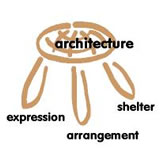 This
period ended with a new nuance in my architecture. The built environment’s
place in society had a different meaning to me than when
I started this cycle of work. I started my work thinking of architecture
as ART in the traditional sense. I ended this period applying
architecture to the task of solving human and social problems.
I do not believe that this is at sacrifice to art - done right,
art and life augment one another. By this time USE
had become part of my practice model. The next 22 years became,
almost exclusively, the application of this idea. To me, even
the best of our present architecture - architecture of great artistic
and technological quality - architecture that can be considered
modern in every sense but one, FAILS in one respect: the
paradigm of USE. The most advanced works are still based
on 19th Century concepts of building types and processes modified
by new technologies and incremental design strategies. At the
ROOT of it, little has changed. This is particularly true
of the so called modern
workplace. This
period ended with a new nuance in my architecture. The built environment’s
place in society had a different meaning to me than when
I started this cycle of work. I started my work thinking of architecture
as ART in the traditional sense. I ended this period applying
architecture to the task of solving human and social problems.
I do not believe that this is at sacrifice to art - done right,
art and life augment one another. By this time USE
had become part of my practice model. The next 22 years became,
almost exclusively, the application of this idea. To me, even
the best of our present architecture - architecture of great artistic
and technological quality - architecture that can be considered
modern in every sense but one, FAILS in one respect: the
paradigm of USE. The most advanced works are still based
on 19th Century concepts of building types and processes modified
by new technologies and incremental design strategies. At the
ROOT of it, little has changed. This is particularly true
of the so called modern
workplace.
The
PROCESSES on which architecture based are not adequate.
Another
reoccurring theme, during this period, was the relationship of
the building both to the landscape in general and the ground in
particular. It became clear to me how devastating the traditional
marriage of building to ground can be in many (not all) circumstances.
Earth and building can and should be intimately connected in that
architecture designed to last for centuries. A good portion, however,
of architecture is more transient for many social and economic
reasons. This is particularly true in the early periods of land
development. In this case, a different strategy is required. Employing
(and deploying) architecture that can easily be sited, used and
moved radically changes the development
process and the economic basis upon which it sits. Different
strategies of ownership (stewardship) are also critical if we
are to avoid the unnecessary wholesale destruction of our landscape
and ecology.
By
the end of SCAN (1952 through 1979), I had explored in
my own design work and my work for other architects, builders
and developers, almost every building type, social application
and economic context that still interests me today. This makes
up and architecture of solution types that can act as a
high level pattern language to a variety of specific design challenges.
This is a legacy that I intend to develop over the coming years.
The
FOCUS phase, that followed this beginning phase, lasted
22 years before the transition to ACT started to get underway.
Indeed, the Focus phase may overlap Act and last a few years yet.
I never expected this, of course. However, there has been a heuristic
logic to my architectural efforts which has now, slowly, gone
full cycle back to the beginning. It does add up although it take
a broad perspective to see it.The Focus phase corresponds, roughly,
with the development of the MG Taylor family of corporations and
their maturation in the marketplace. The close coupling of process,
technology and environment and the iterative learning and prototyping
of design, build, use methods composed this Focus work.
The later projects, starting with #96, are the transition
works to ACT.
•
Part 1a
• Part
2 of 3 • Part
3 of 3 • Narrative
•
|
Matt
Taylor
Palo Alto
March 24, 2001

SolutionBox
voice of this document:
VISION • STRATEGY • EVALUATION
posted
March 24, 2001
revised
May 18, 2001
•
20010324.242345.mt • 20010407.21124356.mt
• 20010407.778932.mt •
• 20010408.663981.mt • 20010414.283622.mt
• 200010506.376651.mt •
• 20010413.299122.mt •
20010518.543291.mt • 20011115.542987.mt
•
• 20011221.298888.mt •
(note:
this document is about 50% finished)
Matt
Taylor 650 814 1192
me@matttaylor.com
Copyright©
Matt Taylor 1958, 1960, 1962, 1971, 1973, 1974, 1975, 1976, 1978, 1979,
2001
|

